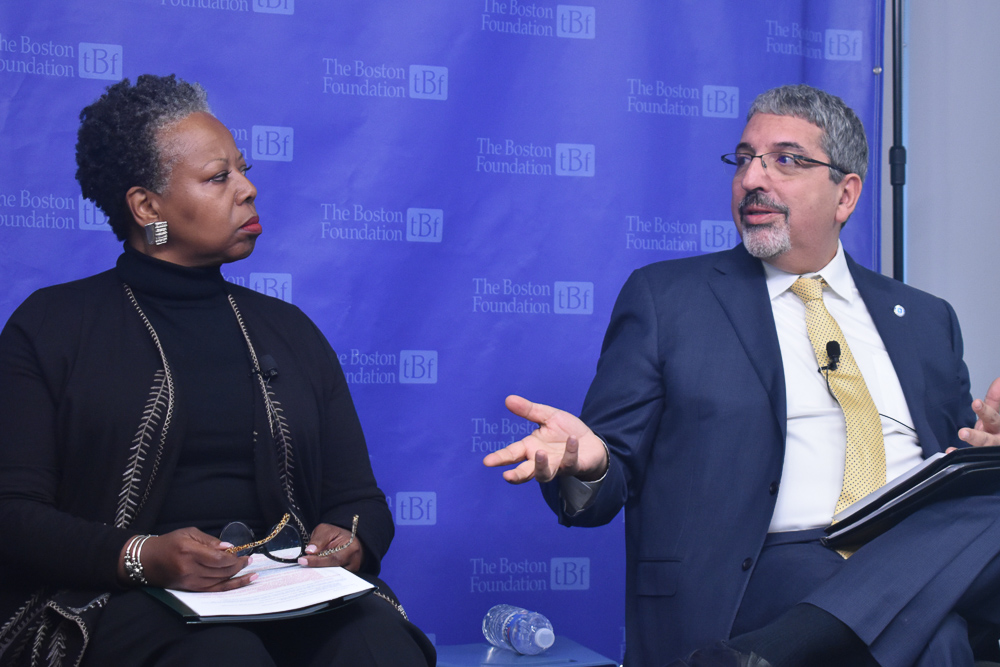Performance funding for community colleges: A short-lived experiment, or blueprint for the future?
A look back at 2013 funding formula could feed future considerations
December 11, 2018
By Antoniya Marinova, Senior Program Officer, Education to Career
Community colleges provide the most accessible pathway to new educational and career opportunities. In Massachusetts, our 15 community colleges serve more than 120,000 students, who are far more likely to remain in the state and contribute to the local economy than students at four-year colleges and universities. For the Boston Foundation, the vital role of community colleges for the Commonwealth’s prosperity is nothing new. And neither is our support for the sector, having commissioned multiple studies and convened the Coalition FOR Community Colleges, a that played a key role in passage of the landmark community college governance and funding reforms in 2013.
On December 4, 2018, the Boston Foundation convened an Understanding Boston forum to release a new report by the Massachusetts Taxpayers Foundation, Grade Incomplete: Implementation of the Community College Funding Formula in Massachusetts. The report’s presentation, and the discussion that followed, took stock of what has happened in recent years with the community college funding formula. Phased out in fiscal year 2017, the formula was originally designed to allocate funds based largely on enrollment and performance indicators rather than previous years’ allocations or political considerations. More importantly, the forum reinvigorated the broader conversation about the vital role of community colleges to the state’s economic success. Prompted by the study’s findings, the panel conversation coalesced around a number of key themes, foremost of which was equity.
The two community college presidents on the panel—Lane Glenn of Northern Essex Community College and Luis Pedraja of Quinsigamond Community College—noted that, while well-intentioned, performance funding formulas likely will not make a difference for the community college students they seek to help, if they don’t recognize and reflect the unique needs and challenges students face. Community colleges serve the most disadvantaged students in higher education. These students are more likely to have multiple jobs and family responsibilities. Far too often, they struggle with hunger or homelessness. They enroll in fewer courses and typically take longer to graduate. Presidents Pedraja and Glenn suggested those different circumstances didn’t get consideration in the formula’s original metrics, which President Pedraja argued were better suited for typical 4-year college students.
President Glenn suggested, too, that performance-based funding mechanisms can in fact exacerbate inequities in funding. Most students live within a few miles from their community college and will not “follow the money” if funding flows from their underperforming college to another campus. For them, Glenn said, the critical decision is whether to enroll in college, not where to enroll. If they perceive their local community college is underperforming and under-resourced, they are more likely to simply stop attending rather than find a better-performing and better-funded college elsewhere in the state.
Instead, the two presidents suggested that we must more effectively decide what we want to achieve, figure out what it will take, and allocate funds accordingly. Both presidents highlighted the importance of high-touch supports and wrap-around services, including coaching and mentoring to help students navigate the world of higher education. Especially beneficial for first generation low-income college students, this type of transition coaching has been the core intervention of Success Boston for a decade, pairing 1,000 students from each graduating class with a coach for the first two years of their college experience. However, it can be resource intensive, and funding formulas that don’t appreciate the benefits may not account for the costs.
Commissioner Carlos Santiago also highlighted equity, noting that the Commonwealth’s Board of Higher Education prepares to launch a year-long strategic planning process with an explicit focus on equity and top priorities related to access, affordability, and closing gaps in student success. The latter looms particularly large in light of a recent report No. 1 for Some by the Massachusetts Education Equity Partnership. Funded in part by the Boston Foundation, the report found that while Massachusetts leads the nation on a whole host of education metrics, our achievement gaps are among the largest. Commissioner Santiago pointed to a number of strategies and reforms he sees as game changers, including sweeping revisions to developmental education, efforts to alleviate food and housing insecurity on college campuses, and plans to address college affordability. He suggested that these efforts would require a new type of funding formula—since conversations about goals and metrics, critical to the design of such formulas, have moved much further along than they were five years ago.
Initiating conversations about a new formula would be a relief to the business community, suggested Dan O’Connell, President and CEO of the Massachusetts Competitive Partnership. On the panel, O’Connell expressed concern about the potential abandonment of relevant metrics spelled out by the 2013 funding formula, and voiced support for a renewal of the metrics-driven funding mechanism. He added that, since Massachusetts thrives on talent, both curricular alignment with workforce needs and the ability to track graduates’ outcomes after college are critical for ensuring both equity and economic success.
To motivate and reward workforce alignment, the Boston Foundation just launched the application process for the Patrick Prize for Community Colleges and invited all 15 community colleges to nominate a program. Now in its fifth year, the Patrick Prize seeks to recognize community college programs that exemplify strong partnerships with employers, meet the economic needs of their region and its employers, and strengthen their graduates’ success in the workforce. This year’s winning program will be announced in the spring of 2019.
View the full recording of the forum here.


